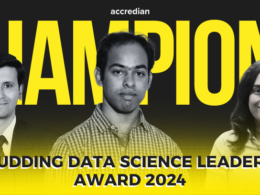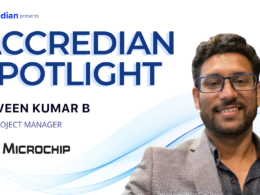At Accredian, we create accomplished and empowered Data Leaders.
We groom our students to dominate the world of Data Science and Artificial Intelligence and reshape their future. We value what our students bring to the table. We share their vision and support them during their journey and ensure that they carve a niche for themselves.
We’re proud to have tutored exceptional students all across India. Today, one such exceptional student, Ashish Kumar Sahu stands in the spotlight.
Student Name: Ashish Kumar Sahu
Batch: GCDAI – January 2019
Total years of experience: 13 years
Area of expertise: Quality Assurance
Malvika: Hi Ashish, before we begin, can you walk me through your professional journey so far?
Ashish: I have completed my postgraduate diploma from Symbiosis-Pune. Then, I ran my own firm for 1.5-2 years. In June 2006, I joined as S1 services as a Java developer where I switched from manual QA to automation QA. Since then, I’m into quality assurance. Currently, I‘m working as a Senior Quality Assurance Engineer at ACI Worldwide. I have an overall experience of 13 years.
Malvika: Ashish, what got you interested in Data Science and Machine Learning?
Ashish: The field always looked very appealing to me. Data Science is nothing but a combination of statistics, coding and domain knowledge. I love coding and statistics and domain knowledge one learns with experience anyway.
While it is a very scientific kind of procedure but you don’t always know what is going to come out of the dataset with which you’re playing around. That’s where you hit and try and figure out. I like that kind of challenge.
Malvika: Can you talk to me about some current trends in the Data Science or Artificial Intelligence industry that you are excited about?
Ashish: There are many trends, especially in the medical field. Let me talk about a popular application in the real world, recommendation engines. Recently, I logged into a website that sells books and it recommended a plethora of other books based upon my previous search. These kind of applications, that are not only helpful for businesses but also for the overall customer experience, are the ones that catch my attention the most.
Chatbots are also an interesting avenue. Late-night support, after-hours support, especially if you are working in IT, is an easier experience.
Malvika: How do you think Data Science has evolved over the past few years?
Ashish: Let me talk about how Data Science has evolved in the past decade. Earlier data science was majorly dominated by PhD candidates and analytical professionals who had strong math skills. In about 2010, businesses realized that along with good analysts they needed people with sound business knowledge to act on these decisions. That’s when we started included business analytics.
![]() It’s very cumbersome to churn the new and huge sets of data. That’s when coders came to play. Eventually, we combined analytical skills with coding skills and domain knowledge and that’s how a Data Scientist’s anatomy came into being.
It’s very cumbersome to churn the new and huge sets of data. That’s when coders came to play. Eventually, we combined analytical skills with coding skills and domain knowledge and that’s how a Data Scientist’s anatomy came into being.
Malvika: What do you think is the goal of Data Science?
Ashish: Malvika, from whatever I have observed so far, I know that Data Science is for improving business. Whatever technology we develop in the future, whatever analytics or statistics we use, the end goal will always be to improve the business; to increase the revenue. It can also extend to socioeconomic causes like predicting cancer in patients.
Malvika: Ashish, are there any Data Science blogs that you follow?
Ashish: My favorite is towardsdatascience. The pieces are simple and easy to follow. I’d recommend them to anyone out there.
Malvika: Are there any Python packages and libraries that you like to use?
Ashish: Malvika, as a coder I’ve written my own customized methods for doing some Exploratory Data Research using Pandas from Python. I have also used some packages for Data Visualization. Writing my own methods has helped me reduce the number of lines of code that I should be writing originally.
For cleaning up columns using logistic regression, we use mode. I wrote the method myself and all I have to do is apply it to a data frame and it will do the rest.
Malvika: At Accredian, students are encouraged to build high-quality GitHub profiles. Have you built a GitHub portfolio and how do you think this will help you?
Ashish: I was working with GitHub earlier as well. Although I didn’t know that you could upload your projects there as well. Adding your projects to GitHub is a great value addition. In the corporate world, before recruiters actually meet you they have an idea of what you’ve done so far, your achievements and your work. It saves time.
Malvika: Crafting a great Data Science resume is a critical part of getting shortlisted for Data Science roles. Can you tell me some ways in which you have improved your resume as a part of Data Science Career Launchpad?
Ashish: Yes, I’ll discuss this point-wise.
Firstly, I got the opportunity to create a master resume.
Secondly, I understood the importance of drafting a customized resume for every profile that I’ll apply to.
Thirdly, linking your LinkedIn and Github to your resume is very crucial. The impact that your projects have created is critical to discuss. That was something missing from my resume as well.
Malvika: Accredian’s mission is to groom Data Leaders of tomorrow, what do you understand by a data leader? And how do you think a data leader is different from a data scientist?
Ashish: When a data scientist starts guiding people, community and business, they start becoming a Data leader. They are influencers, who are sharing their knowledge with the community. They have a better understanding of how business works and they apply their knowledge to extract actionable insights.
Malvika: These are all the questions I have for you today. Thank you for sharing your time with us. Good luck for the future, Ashish!





